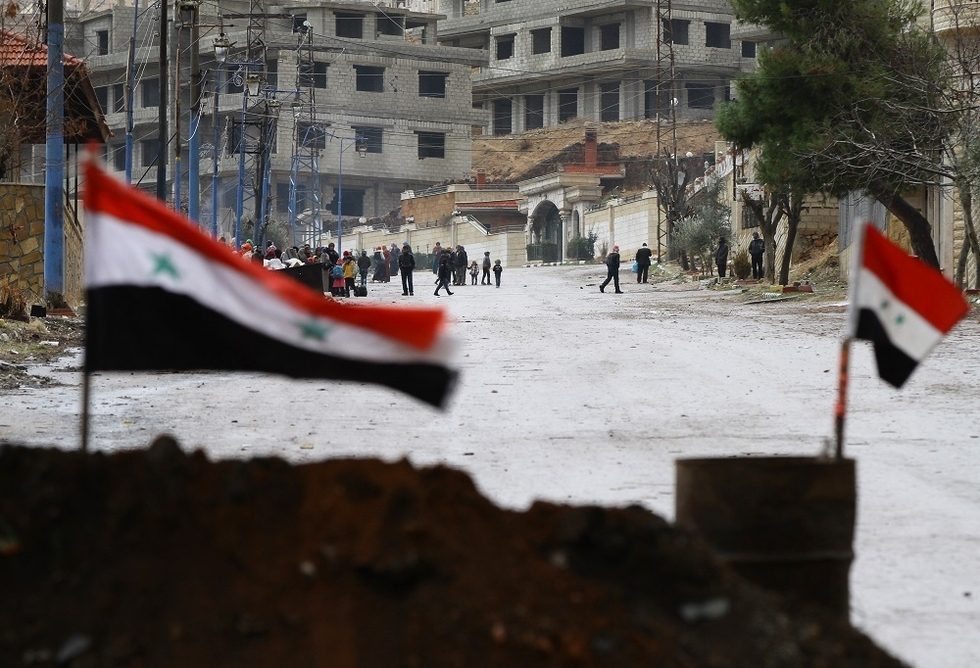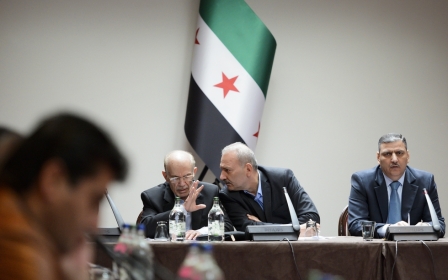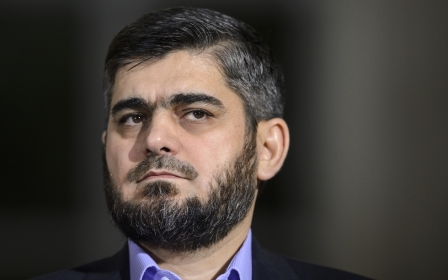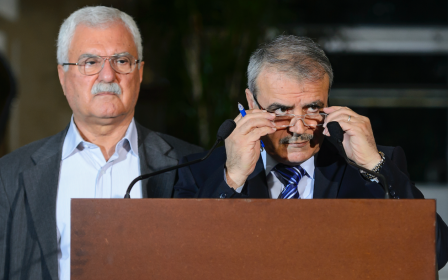Hunger pushing Madaya residents into minefields in bid to find food

By Mohammed Al-Haj Ali, Maher al-Hamdan and Maria Nelson
AMMAN, Jordan: On a dark, cold night in January, Hussein Madaya walked straight into a minefield in a desperate bid to bring food back for his wife and children in the starving, government-encircled town of Madaya.
“It had been a strange day,” Hussein, a 40-year-old father of four, told Syria Direct, using a pseudonym. “Food was scarce, people were hysterical. I decided to leave Madaya and cross the minefields at night.”
He did not know exactly where he was heading, but where he was coming from had no food at all. There had to be something outside the blockade, he thought.
Hussein was walking with several others through an agricultural area of the wide plain just west of Madaya, with the Qalamoun mountains rising in the distance, when “the ground convulsed and I felt a strong explosion,” he said. “I didn’t immediately realise that I had lost my foot.” He had stepped on a mine in the dark.
“The pain was worse than you can imagine.”
An estimated 8,000 landmines lie directly to the west, south and east of Madaya, Hussam Madaya, an activist in the town and local council member told Syria Direct.
Part of what makes the blockade of Madaya and Baqin so airtight is that the neighbouring Outer Damascus towns are surrounded by the thousands of mines planted by Hezbollah fighters in the summer of 2015. The explosive devices, backed up by government and Hezbollah snipers, ensure that virtually nobody and nothing can get in or out.
“These minefields are essentially the line of the blockade,” Madaya citizen journalist Ghassan a-Shami told Syria Direct.
Hussein knew the risk he was taking by trying to slip through the nearly 10-month blockade of Madaya, 40km northwest of Damascus. Formerly known as a summer resort town, it shot to prominence in early 2016 amidst reports of mass starvation following months of blockades by the Syrian government and its ally Hezbollah.
“I knew that area was dangerous,” Hussein, a mechanic by trade, told Syria Direct. He risked losing a limb to a mine or his life to a sniper by venturing into the dark. But he was hungry and his family was hungry, so he continued with his quest.
Syrian government forces and Hezbollah imposed a blockade on Madaya and adjacent Baqin in July 2015 amidst a battle for control of neighbouring rebel-held Zabadani, a gateway to key smuggling routes across the Qalamoun mountains into Lebanon.
Up to 40,000 people are now trapped in encircled Madaya and neighbouring Baqin. They are among an estimated one million people living under blockades in Syria, according to the Siege Watch monitoring organisation, a figure which includes two villages that rebels have encircled in Idlib province.
Rebel-held Madaya and neighbouring Baqin entered into a truce agreement with the government in September 2015 that stipulated the entrance of aid to government-controlled villages Kafariya and al-Fuaa in Syria’s north in exchange for the government doing the same in rebel-held Zabadani.
The standing agreement is built on reciprocity: aid for Madaya means aid for al-Fuaa and Kafariya, and vice versa. The same applies to evacuations of fighters, civilians and the wounded.
Though about half a dozen aid convoys have entered the town this year, and some of the medically urgent have been allowed to leave, a list of more than 100 people are on an urgent list awaiting medical evacuation. The blockade still stands.
At least 30 civilians have been killed by landmines or snipers trying to pass through Madaya's security cordon, according to a January report by the Syrian American Medical Society.
“Government and allied Hezbollah forces have put landmines around Madaya, making it incredibly dangerous and difficult for civilians to leave or for anyone to smuggle food into the towns,” the report concluded.
“Mines have blown up many civilians who tried to flee the blockade,” Madaya activist a-Shami told Syria Direct. “Those who don’t die in the mine blast are in danger from snipers at nearby military positions, who are alerted by the explosion.”
Since last fall, the landmines surrounding Madaya and Baqin have killed 10 people, Mohammed Darwish, a doctor at the Madaya field hospital, told Syria Direct last week. An additional 12, like Hussein, lost at least one limb to the mines.
“There aren’t any specialists for cases like these,” said Darwish. “We give them first aid, stop the bleeding, make sure they’re breathing,” he said, adding that when patients are medically stable, “we perform an amputation using rudimentary materials.”
“The vast majority of the injuries require amputation.”
‘No mine-clearing specialists’
Syria is not among the 162 signatories to the 1997 Mine Ban Treaty prohibiting the use of antipersonnel mines. The treaty also stipulates the destruction of countries’ stockpiles of the weapons.
The United Nations Mine Action Service (UNMAS) estimates that 5.1 million people in Syria, including 2 million children, are living in areas “highly contaminated” by “landmines, explosive remnants of war, improvised explosive devices, artisanal mines, some of which are connected to booby traps, coalition UXO [unexploded ordnance] and cluster munitions”.
The landmines surrounding Madaya and Baqin pose an ongoing danger even to those residents not actively trying to get around the blockade.
In late March, three boys aged between six and seven found a landmine while walking home from their school in Baqin, administratively part of Madaya. They picked it up thinking it was a toy or a can of food, the Syrian American Medical Society reported. It detonated, killing one child instantly while the other two later died as medical personnel and their families made futile attempts to have them evacuated to Damascus hospitals.
“There are no mine-clearing specialists in the area,” activist a-Shami told Syria Direct. There have been some ad-hoc efforts by untrained residents to remove the deadly devices, but the minefields “are between military positions, so they are in firing range and teams can’t get close to them easily.”
Government forces and their allies, rebel groups and the Islamic State have all heavily used explosive ordnance over the past five years of war in Syria. The remnants of those explosives will likely continue to pose a danger long after the fighting ends.
Unable to remove the existing mines, local activists “are trying to raise awareness, telling people to stay away from them,” Madaya told Syria Direct.
The original version of this story first appeared in Syria Direct and is reprinted here with their permission.Middle East Eye propose une couverture et une analyse indépendantes et incomparables du Moyen-Orient, de l’Afrique du Nord et d’autres régions du monde. Pour en savoir plus sur la reprise de ce contenu et les frais qui s’appliquent, veuillez remplir ce formulaire [en anglais]. Pour en savoir plus sur MEE, cliquez ici [en anglais].




